A Solar and Wind Energy Evaluation Methodology Using Artificial Intelligence Technologies
Abstract
1. Introduction
- depletion of traditional natural resources;
- rapid growth in the amount of energy consumed;
- the need for increased energy independence;
- the desire to reduce carbon “dependence” and greenhouse gas emissions.
- large uncertainty concerning the scenario parameters in the design of energy systems [21];
- complexity of modeling and forecasting the amount of incoming and generated energy [22];
- the presence of various system errors in the operation of energy systems;
- the complexity of the optimization of the system’s operating process.
2. Materials and Methods
2.1. Artificial Intelligence in Solar and Wind Power Forecasting
- estimating the theoretical energy potential;
- forecasting the efficiency of renewable energy involvement;
- forecasting the amount of energy production;
- organization of the intelligent control of the operating modes of such energy systems;
- fault detection and diagnosis;
- multi-level system optimization;
- stochastic uncertainty analysis.
- using images of the plant in operation, computer vision methods can be applied to perform preliminary monitoring of the technical state of the system;
- time series with information on operating modes can serve as a basis for the development of models used for preventive maintenance, thus preventing technical failures;
- information on energy production can be used to develop forecasting models aimed at building trends and forecasts of energy production.
2.2. Data Processing Methods
- filling negative values with zeros (provided that the values cannot be negative, e.g., energy generation volumes);
- excluding missing values;
- data normalization procedures to reduce regression errors and maintain high correlation.
- data loading;
- statistical analysis;
- data processing;
- data segmentation;
- interpretation and application of the results.
2.3. RES Forecasting Methods
2.4. Using AI Technologies for Forecasting in the Renewable Energy Industry
- Supervised learning is used to learn from data while providing initial correct answers or data labels.
- Unsupervised learning is characterized by the absence of initially given labels, unlike when supervised learning is applied, so the algorithm needs to combine and interpret related data.
- Reinforcement learning: a reinforcement learning algorithm receives feedback, with any correct prediction contributing to increased accuracy.
- Ensemble learning: although the three classes listed above cover most areas, model performance also tends to improve. In such cases, it can be useful to use ensemble approaches to improve accuracy, combining several traditional AI approaches.
2.5. Digital Twins in Energy Systems with RES Utilization
- physical products in real space;
- virtual products in virtual space;
- data and information connections that link virtual and real products together [65].
- Design phase:
- -
- optimization;
- -
- data generation;
- -
- virtual evaluation;
- Operation phase:
- -
- monitoring;
- -
- production control;
- -
- process forecasting;
- -
- process optimization and planning;
- Maintenance phase:
- -
- predictive maintenance;
- -
- fault detection and diagnosis;
- -
- virtual testing.
3. Methodology for Using AI Approaches in RES Forecasting and Assessment
3.1. Implementation of Experimental Studies
Stages of Realization
4. Conclusions
Author Contributions
Funding
Data Availability Statement
Conflicts of Interest
References
- Hosseini, S.E.; Wahid, M.A. Utilization of palm solid residue as a source of renewable and sustainable energy in Malaysia. Renew. Sustain. Energy Rev. 2014, 40, 621–632. [Google Scholar] [CrossRef]
- Hosseini, S.E.; Abdul Wahid, M. Pollutant in palm oil production process. J. Air Waste Manag. Assoc. 2015, 65, 773–781. [Google Scholar] [CrossRef] [PubMed]
- Dai, H.; Huang, G.; Zeng, H. Multi-objective optimal dispatch strategy for power systems with Spatio-temporal distribution of air pollutants. Sustain. Cities Soc. 2023, 98, 104801. [Google Scholar] [CrossRef]
- Dai, H.; Huang, G.; Wang, J.; Zeng, H. VAR-tree model based spatio-temporal characterization and prediction of O3 concentration in China. Ecotoxicol. Environ. Saf. 2023, 257, 114960. [Google Scholar] [CrossRef]
- Ma, W.; Yuan, Z.; Lau, A.K.; Wang, L.; Liao, C.; Zhang, Y. Optimized neural network for daily-scale ozone prediction based on transfer learning. Sci. Total Environ. 2022, 827, 154279. [Google Scholar] [CrossRef]
- Manisalidis, I.; Stavropoulou, E.; Stavropoulos, A.; Bezirtzoglou, E. Environmental and health impacts of air pollution: A review. Front. Public Health 2020, 8, 14. [Google Scholar] [CrossRef] [PubMed]
- Panwar, N.L.; Kaushik, S.C.; Kothari, S. Role of renewable energy sources in environmental protection: A review. Renew. Sustain. Energy Rev. 2011, 15, 1513–1524. [Google Scholar] [CrossRef]
- Elliott, D. Renewable energy and sustainable futures. Futures 2000, 32, 261–274. [Google Scholar] [CrossRef]
- Evans, A.; Strezov, V.; Evans, T.J. Assessment of sustainability indicators for renewable energy technologies. Renew. Sustain. Energy Rev. 2009, 13, 1082–1088. [Google Scholar] [CrossRef]
- Yolcan, O.O. World energy outlook and state of renewable energy: 10-Year evaluation. Innov. Green Dev. 2023, 2, 100070. [Google Scholar] [CrossRef]
- Kong, L.S.; Tan, X.C.; Gu, B.H.; Yan, H.S. Significance of achieving carbon neutrality by 2060 on China’s energy transition pathway: A multi-model comparison analysis. Adv. Clim. Chang. Res. 2023, 14, 32–42. [Google Scholar] [CrossRef]
- Buchatsky, P.Y.; Onishchenko, S.V.; Teploukhov, S.V.; Lisova, A.N. New technologies of renewable energy conversion. In Proceedings of the Fundamental and Applied Aspects of Geology, Geophysics and Geoecology Using Modern Information Technologies, Maykop, Russia, 15–19 May 2023; pp. 49–57. (In Russian). [Google Scholar]
- Jin, C.; Lv, Z.; Li, Z.; Sun, K. Green finance, renewable energy and carbon neutrality in OECD countries. Renew. Energy 2023, 211, 279–284. [Google Scholar] [CrossRef]
- Climate Action Tracker. Available online: https://climateactiontracker.org/global/cat-net-zero-target-evaluations/ (accessed on 1 November 2023).
- IEA International Energy Agency. Available online: https://www.iea.org/data-and-statistics/charts/annual-clean-energy-investment-2017-2022 (accessed on 1 November 2023).
- Mitchell, C.; Connor, P. Renewable energy policy in the UK 1990–2003. Energy Policy 2004, 32, 1935–1947. [Google Scholar] [CrossRef]
- Bugaje, I.M. Renewable energy for sustainable development in Africa: A review. Renew. Sustain. Energy Rev. 2006, 10, 603–612. [Google Scholar] [CrossRef]
- Menegaki, A. Valuation for renewable energy: A comparative review. Renew. Sustain. Energy Rev. 2008, 12, 2422–2437. [Google Scholar] [CrossRef]
- Bajpai, P.; Dash, V. Hybrid renewable energy systems for power generation in stand-alone applications: A review. Renew. Sustain. Energy Rev. 2012, 16, 2926–2939. [Google Scholar] [CrossRef]
- Alemán-Nava, G.S.; Casiano-Flores, V.H.; Cárdenas-Chávez, D.L.; Díaz-Chavez, R.; Scarlat, N.; Mahlknecht, J.; Dallemand, J.-F.; Parra, R. Renewable energy research progress in Mexico: A review. Renew. Sustain. Energy Rev. 2014, 32, 140–153. [Google Scholar] [CrossRef]
- Zhou, Y.; Zheng, S.; Zhang, G. Machine-learning based study on the on-site renewable electrical performance of an optimal hybrid PCMs integrated renewable system with high-level parameters’ uncertainties. Renew. Energy 2020, 151, 403–418. [Google Scholar] [CrossRef]
- Simankov, V.S. Automation of System Research: A Monograph; Scientific Publication: Krasnodar, Russia, 2002; p. 376. [Google Scholar]
- Zhao, E.; Sun, S.; Wang, S. New developments in wind energy forecasting with artificial intelligence and big data: A scientometric insight. Data Sci. Manag. 2022, 5, 84–95. [Google Scholar] [CrossRef]
- Senocak, A.A.; Goren, H.G. Forecasting the biomass-based energy potential using artificial intelligence and geographic information systems: A case study. Eng. Sci. Technol. Int. J. 2022, 26, 100992. [Google Scholar] [CrossRef]
- Qureshi, S.; Shaikh, F.; Kumar, L.; Ali, F.; Awais, M.; Gürel, A.E. Short-term forecasting of wind power generation using artificial intelligence. Environ. Chall. 2023, 11, 100722. [Google Scholar] [CrossRef]
- Zougagh, N.; Charkaoui, A.; Echchatbi, A. Artificial intelligence hybrid models for improving forecasting accuracy. Procedia Comput. Sci. 2021, 184, 817–822. [Google Scholar] [CrossRef]
- Simankov, V.; Buchatskiy, P.; Teploukhov, S.; Onishchenko, S.; Kazak, A.; Chetyrbok, P. Review of Estimating and Predicting Models of the Wind Energy Amount. Energies 2023, 16, 5926. [Google Scholar] [CrossRef]
- Ashfaq, A.; Kamran, M.; Rehman, F.; Sarfaraz, N.; Ilyas, H.U.; Riaz, H.H. Role of artificial intelligence in renewable energy and its scope in future. In Proceedings of the 2022 5th International Conference on Energy Conservation and Efficiency (ICECE), Lahore, Pakistan, 16–17 March 2022; pp. 1–6. [Google Scholar]
- Srivastava, S.K. Application of artificial intelligence in renewable energy. In Proceedings of the 2020 International Conference on Computational Performance Evaluation (ComPE), Shillong, India, 22–24 July 2020; IEEE: Piscataway, NJ, USA, 2020; pp. 327–331. [Google Scholar]
- Liu, Z.; Sun, Y.; Xing, C.; Liu, J.; He, Y.; Zhou, Y.; Zhang, G. Artificial intelligence powered large-scale renewable integrations in multi-energy systems for carbon neutrality transition: Challenges and future perspectives. Energy AI 2022, 10, 100195. [Google Scholar] [CrossRef]
- Li, Y.; Zhan, J. SAIBench: Benchmarking AI for science. BenchCouncil Trans. Benchmarks Stand. Eval. 2022, 2, 100063. [Google Scholar] [CrossRef]
- Simankov, V.S.; Teploukhov, S.V. Analytical study of artificial intelligence methods and algorithms. Bull. Adyg. State Univ. Ser. 4 Nat. -Math. Tech. Sci. 2020, 3, 16–25. (In Russian) [Google Scholar]
- Liu, W. Integrated Human-Machine Intelligence: Beyond Artificial Intelligence; Elsevier: Amsterdam, The Netherlands, 2023. [Google Scholar]
- Huang, L. System intelligence: Model, bounds and algorithms. In Proceedings of the 17th ACM International Symposium on Mobile Ad Hoc Networking and Computing, Paderborn, Germany, 5–8 July 2016; Association for Computing Machinery: New York, NY, USA, 2016; pp. 171–180. [Google Scholar]
- Simankov, V.S.; Onishchenko, S.V.; Buchatskiy, P.Y.; Teploukhov, S.V. An Approach to the Definition of System Intelligence in the Management of Complex Systems. In Proceedings of the 2023 XXVI International Conference on Soft Computing and Measurements (SCM), Saint Petersburg, Russia, 24–26 May 2023; pp. 159–162. [Google Scholar]
- Yang, S.C.H.; Folke, T.; Shafto, P. The Inner Loop of Collective Human–Machine Intelligence. Top. Cogn. Sci. 2023, 2, 1–24. [Google Scholar] [CrossRef] [PubMed]
- Chatterjee, J.; Dethlefs, N. Facilitating a smoother transition to renewable energy with AI. Patterns 2022, 3, 100528. [Google Scholar] [CrossRef]
- Zhang, L.; Ling, J.; Lin, M. Artificial intelligence in renewable energy: A comprehensive bibliometric analysis. Energy Rep. 2022, 8, 14072–14088. [Google Scholar] [CrossRef]
- Wang, F.; Zhang, Z.; Liu, C.; Yu, Y.; Pang, S.; Duić, N.; Shafie-Khah, M.; Catalao, J.P. Generative adversarial networks and convolutional neural networks based weather classification model for day ahead short-term photovoltaic power forecasting. Energy Convers. Manag. 2019, 181, 443–462. [Google Scholar] [CrossRef]
- Van Der Maaten, L.; Postma, E.O.; van den Herik, H.J. Dimensionality reduction: A comparative review. J. Mach. Learn. Res. 2009, 10, 13. [Google Scholar]
- Cunningham, J.P.; Ghahramani, Z. Linear dimensionality reduction: Survey, insights, and generalizations. J. Mach. Learn. Res. 2015, 16, 2859–2900. [Google Scholar]
- Sumithra, V.; Surendran, S. A review of various linear and non linear dimensionality reduction techniques. Int. J. Comput. Sci. Inf. Technol. 2015, 6, 2354–2360. [Google Scholar]
- Aghajani, A.; Kazemzadeh, R.; Ebrahimi, A. A novel hybrid approach for predicting wind farm power production based on wavelet transform, hybrid neural networks and imperialist competitive algorithm. Energy Convers. Manag. 2016, 121, 232–240. [Google Scholar] [CrossRef]
- Shi, J.; Lee, W.J.; Liu, Y.; Yang, Y.; Wang, P. Forecasting power output of photovoltaic systems based on weather classification and support vector machines. IEEE Trans. Ind. Appl. 2012, 48, 1064–1069. [Google Scholar] [CrossRef]
- Zhu, H.; Li, X.; Sun, Q.; Nie, L.; Yao, J.; Zhao, G. A power prediction method for photovoltaic power plant based on wavelet decomposition and artificial neural networks. Energies 2015, 9, 11. [Google Scholar] [CrossRef]
- Dwivedi, S.K.; Rawat, B. A review paper on data preprocessing: A critical phase in web usage mining process. In Proceedings of the 2015 International Conference on Green Computing and Internet of Things (ICGCIoT), Greater Noida, India, 8–10 October 2015; pp. 506–510. [Google Scholar]
- Maharana, K.; Mondal, S.; Nemade, B. A review: Data pre-processing and data augmentation techniques. Glob. Transit. Proc. 2022, 3, 91–99. [Google Scholar] [CrossRef]
- Wang, H.; Zhang, N.; Du, E.; Yan, J.; Han, S.; Liu, Y. A comprehensive review for wind, solar, and electrical load forecasting methods. Glob. Energy Interconnect. 2022, 5, 9–30. [Google Scholar] [CrossRef]
- Jlidi, M.; Hamidi, F.; Barambones, O.; Abbassi, R.; Jerbi, H.; Aoun, M.; Karami-Mollaee, A. An Artificial Neural Network for Solar Energy Prediction and Control Using Jaya-SMC. Electronics 2023, 12, 592. [Google Scholar] [CrossRef]
- Sehrawat, N.; Vashisht, S.; Singh, A. Solar irradiance forecasting models using machine learning techniques and digital twin: A case study with comparison. Int. J. Intell. Netw. 2023, 4, 90–102. [Google Scholar] [CrossRef]
- Ahmad, T.; Zhu, H.; Zhang, D.; Tariq, R.; Bassam, A.; Ullah, F.; AlGhamdi, A.S.; Alshamrani, S.S. Energetics Systems and artificial intelligence: Applications of industry 4.0. Energy Rep. 2022, 8, 334–361. [Google Scholar] [CrossRef]
- Mellit, A. Artificial Intelligence technique for modelling and forecasting of solar radiation data: A review. Inter. J. Artif. Intell. Soft Comput. 2008, 1, 52–76. [Google Scholar] [CrossRef]
- Zhao, H.X.; Magoulès, F. A review on the prediction of building energy consumption. Renew. Sustain. Energy Rev. 2012, 16, 3586–3592. [Google Scholar] [CrossRef]
- Mellit, A.; Kalogirou, S.A.; Hontoria, L.; Shaari, S. Artificial intelligence techniques for sizing photovoltaic systems: A review. Renew. Sustain. Energy Rev. 2009, 13, 406–419. [Google Scholar] [CrossRef]
- Sharma, N.; Sharma, P.; Irwin, D.; Shenoy, P. Predicting solar generation from weather forecasts using machine learning. In Proceedings of the 2011 IEEE International Conference on Smart Grid Communications (SmartGridComm), Brussels, Belgium, 17–20 October 2011; IEEE: Piscataway, NJ, USA, 2011; pp. 528–533. [Google Scholar]
- Del Ser, J.; Casillas-Perez, D.; Cornejo-Bueno, L.; Prieto-Godino, L.; Sanz-Justo, J.; Casanova-Mateo, C.; Salcedo-Sanz, S. Randomization-based machine learning in renewable energy prediction problems: Critical literature review, new results and perspectives. Appl. Soft Comput. 2022, 118, 108526. [Google Scholar] [CrossRef]
- Li, L.L.; Wen, S.Y.; Tseng, M.L.; Wang, C.S. Renewable energy prediction: A novel short-term prediction model of photovoltaic output power. J. Clean. Prod. 2019, 228, 359–375. [Google Scholar] [CrossRef]
- Xia, M.; Shao, H.; Ma, X.; de Silva, C.W. A stacked GRU-RNN-based approach for predicting renewable energy and electricity load for smart grid operation. IEEE Trans. Ind. Inform. 2021, 17, 7050–7059. [Google Scholar] [CrossRef]
- Ahmad, T.; Zhang, H.; Yan, B. A review on renewable energy and electricity requirement forecasting models for smart grid and buildings. Sustain. Cities Soc. 2020, 55, 102052. [Google Scholar] [CrossRef]
- Xie, Y.; Li, C.; Li, M.; Liu, F.; Taukenova, M. An overview of deterministic and probabilistic forecasting methods of wind energy. iScience 2022, 26, 105804. [Google Scholar] [CrossRef]
- Nascimento, E.G.S.; de Melo, T.A.; Moreira, D.M. A transformer-based deep neural network with wavelet transform for forecasting wind speed and wind energy. Energy 2023, 278, 127678. [Google Scholar] [CrossRef]
- Mabel, M.C.; Fernandez, E. Estimation of energy yield from wind farms using artificial neural networks. IEEE Trans. Energy Convers. 2009, 24, 459–464. [Google Scholar] [CrossRef]
- Shamsi, M.; Cuffe, P. Prediction markets for probabilistic forecasting of renewable energy sources. IEEE Trans. Sustain. Energy 2021, 13, 1244–1253. [Google Scholar] [CrossRef]
- Kong, X.; Liu, X.; Shi, R.; Lee, K.Y. Wind speed prediction using reduced support vector machines with feature selection. Neurocomputing 2015, 169, 449–456. [Google Scholar] [CrossRef]
- Grieves, M. Digital twin: Manufacturing excellence through virtual factory replication. White Pap. 2014, 1, 1–7. [Google Scholar]
- Yu, W.; Patros, P.; Young, B.; Klinac, E.; Walmsley, T.G. Energy digital twin technology for industrial energy management: Classification, challenges and future. Renew. Sustain. Energy Rev. 2022, 161, 112407. [Google Scholar] [CrossRef]
- Massel, L.; Massel, A.; Shchukin, N.; Tsybikov, A. Designing a Digital Twin of a Wind Farm. Eng. Proc. 2023, 33, 30. [Google Scholar]
- Grieves, M. Intelligent digital twins and the development and management of complex systems. Digit. Twin 2022, 2, 8. [Google Scholar] [CrossRef]
- Nguyen, V.H.; Tran, Q.T.; Besanger, Y.; Jung, M.; Nguyen, T.L. Digital twin integrated power-hardware-in-the-loop for the assessment of distributed renewable energy resources. Electr. Eng. 2021, 104, 377–388. [Google Scholar] [CrossRef]
- Buchatskiy, P.Y.; Teploukhov, S.V.; Onishchenko, S.V.; Kuzmin, K.K.; Bychkov, T.Y. Software Tools for Evaluating Renewable Energy Sources. Russ. J. Earth Sci. 2023, 5, 1–8. [Google Scholar] [CrossRef]
- You, M.; Wang, Q.; Sun, H.; Castro, I.; Jiang, J. Digital twins based day-ahead integrated energy system scheduling under load and renewable energy uncertainties. Appl. Energy 2022, 305, 117899. [Google Scholar] [CrossRef]
- Belik, M.; Rubanenko, O. Implementation of Digital Twin for Increasing Efficiency of Renewable Energy Sources. Energies 2023, 16, 4787. [Google Scholar] [CrossRef]
- Kumar, R.D.; Prakash, K.; Sundari, P.A.; Sathya, S. A Hybrid Machine Learning Model for Solar Power Forecasting. E3S Web Conf. 2023, 387, 04003. [Google Scholar] [CrossRef]
- Roy, A.; Ramanan, A.; Kumar, B.; Abraham, C.A.; Hammer, A.; Barykina, E.; Heinemann, D.; Kumar, N.; Waldl, H.-P.; Mitra, I.; et al. Development of a day-ahead solar power forecasting model chain for a 250 MW PV park in India. Int. J. Energy Environ. Eng. 2023, 14, 973–989. [Google Scholar] [CrossRef]
- Nayak, A.; Heistrene, L. Hybrid machine learning model for forecasting solar power generation. In Proceedings of the 2020 International Conference on Smart Grids and Energy Systems (SGES), Perth, Australia, 23–26 November 2020; pp. 910–915. [Google Scholar]
- Jalali, S.M.J.; Ahmadian, S.; Nakisa, B.; Khodayar, M.; Khosravi, A.; Nahavandi, S.; Islam, S.M.S.; Shafie-Khah, M.; Catalão, J.P. Solar irradiance forecasting using a novel hybrid deep ensemble reinforcement learning algorithm. Sustain. Energy Grids Netw. 2022, 32, 100903. [Google Scholar] [CrossRef]
- Lim, S.C.; Huh, J.H.; Hong, S.H.; Park, C.Y.; Kim, J.C. Solar Power Forecasting Using CNN-LSTM Hybrid Model. Energies 2022, 15, 8233. [Google Scholar] [CrossRef]
- Margaret, V.; Jose, J. Exponential smoothing models for prediction of solar irradiance. Int. J. Adv. Res. Electr. Electron. Instrum. Eng. 2015, 4, 1133–1139. [Google Scholar]
- Dong, Z.; Yang, D.; Reindl, T.; Walsh, W.M. Short-term solar irradiance forecasting using exponential smoothing state space model. Energy 2013, 55, 1104–1113. [Google Scholar] [CrossRef]
- Dev, S.; AlSkaif, T.; Hossari, M.; Godina, R.; Louwen, A.; Van Sark, W. Solar irradiance forecasting using triple exponential smoothing. In Proceedings of the 2018 International Conference on Smart Energy Systems and Technologies (SEST), Seville, Spain, 10–12 September 2018; IEEE: Piscataway, NJ, USA, 2018; pp. 1–6. [Google Scholar]
- Gupta, A.; Bansal, A.; Roy, K. Solar energy prediction using decision tree regressor. In Proceedings of the 2021 5th International Conference on Intelligent Computing and Control Systems (ICICCS), Madurai, India, 6–8 May 2021; IEEE: Piscataway, NJ, USA, 2021; pp. 489–495. [Google Scholar]
- Ahmad, M.W.; Reynolds, J.; Rezgui, Y. Predictive modelling for solar thermal energy systems: A comparison of support vector regression, random forest, extra trees and regression trees. J. Clean. Prod. 2018, 203, 810–821. [Google Scholar] [CrossRef]
- Chen, H.; Chang, X. Photovoltaic power prediction of LSTM model based on Pearson feature selection. Energy Rep. 2021, 7, 1047–1054. [Google Scholar] [CrossRef]
- Jailani, N.L.M.; Dhanasegaran, J.K.; Alkawsi, G.; Alkahtani, A.A.; Phing, C.C.; Baashar, Y.; Capretz, L.F.; Al-Shetwi, A.Q.; Tiong, S.K. Investigating the Power of LSTM-Based Models in Solar Energy Forecasting. Processes 2023, 11, 1382. [Google Scholar] [CrossRef]
- Center for Intelligent Digital Power Engineering Institute of Management Problems of the Russian Academy of Sciences. Available online: https://energy.ipu.ru/datasets/#power-climate-2020 (accessed on 6 November 2023).
- Saghiri, A.M.; Vahidipour, S.M.; Jabbarpour, M.R.; Sookhak, M.; Forestiero, A. A survey of artificial intelligence challenges: Analyzing the definitions, relationships, and evolutions. Appl. Sci. 2022, 12, 4054. [Google Scholar] [CrossRef]
- Bhagoji, A.N.; Cullina, D.; Sitawarin, C.; Mittal, P. Enhancing robustness of machine learning systems via data transformations. In Proceedings of the 2018 52nd Annual Conference on Information Sciences and Systems (CISS), Princeton, NJ, USA, 21–23 March 2018; pp. 1–5. [Google Scholar]
- Fateh, D.; Eldoromi, M.; Birjandi, A.A.M. Uncertainty modeling of renewable energy sources. In Scheduling and Operation of Virtual Power Plants; Zangeneh, A., Moeini-Aghtaie, M., Eds.; Elsevier: Amsterdam, The Netherlands, 2022; pp. 193–208. [Google Scholar]
- Alonso-Travesset, À.; Coppitters, D.; Martín, H.; de la Hoz, J. Economic and Regulatory Uncertainty in Renewable Energy System Design: A Review. Energies 2023, 16, 882. [Google Scholar] [CrossRef]
- Billah, B.; King, M.L.; Snyder, R.D.; Koehler, A.B. Exponential smoothing model selection for forecasting. Int. J. Forecast. 2006, 22, 239–247. [Google Scholar] [CrossRef]
- Chandola, D.; Gupta, H.; Tikkiwal, V.A.; Bohra, M.K. Multi-step ahead forecasting of global solar radiation for arid zones using deep learning. Procedia Comput. Sci. 2020, 167, 626–635. [Google Scholar] [CrossRef]
- Ağbulut, Ü.; Gürel, A.E.; Biçen, Y. Prediction of daily global solar radiation using different machine learning algorithms: Evaluation and comparison. Renew. Sustain. Energy Rev. 2021, 135, 110114. [Google Scholar] [CrossRef]
- Ahmed, R.; Sreeram, V.; Mishra, Y.; Arif, M.D. A review and evaluation of the state-of-the-art in PV solar power forecasting: Techniques and optimization. Renew. Sustain. Energy Rev. 2020, 124, 109792. [Google Scholar] [CrossRef]
- Harrou, F.; Kadri, F.; Sun, Y. Forecasting of photovoltaic solar power production using LSTM approach. In Advanced Statistical Modeling, Forecasting, and Fault Detection in Renewable Energy Systems; IntechOpen: London, UK, 2020; Volume 3. [Google Scholar]
- Ghimire, S.; Deo, R.C.; Raj, N.; Mi, J. Deep solar radiation forecasting with convolutional neural network and long short-term memory network algorithms. Appl. Energy 2019, 253, 113541. [Google Scholar] [CrossRef]
- Lateko, A.A.; Yang, H.T.; Huang, C.M.; Aprillia, H.; Hsu, C.Y.; Zhong, J.L.; Phương, N.H. Stacking ensemble method with the RNN meta-learner for short-term PV power forecasting. Energies 2021, 14, 4733. [Google Scholar] [CrossRef]
- Bozkurt, H.; Macit, R.; Çelik, Ö.; Teke, A. Evaluation of artificial neural network methods to forecast short-term solar power generation: A case study in Eastern Mediterranean Region. Turk. J. Electr. Eng. Comput. Sci. 2022, 30, 2013–2030. [Google Scholar] [CrossRef]
- Meng, M.; Song, C. Daily photovoltaic power generation forecasting model based on random forest algorithm for north China in winter. Sustainability 2020, 12, 2247. [Google Scholar] [CrossRef]
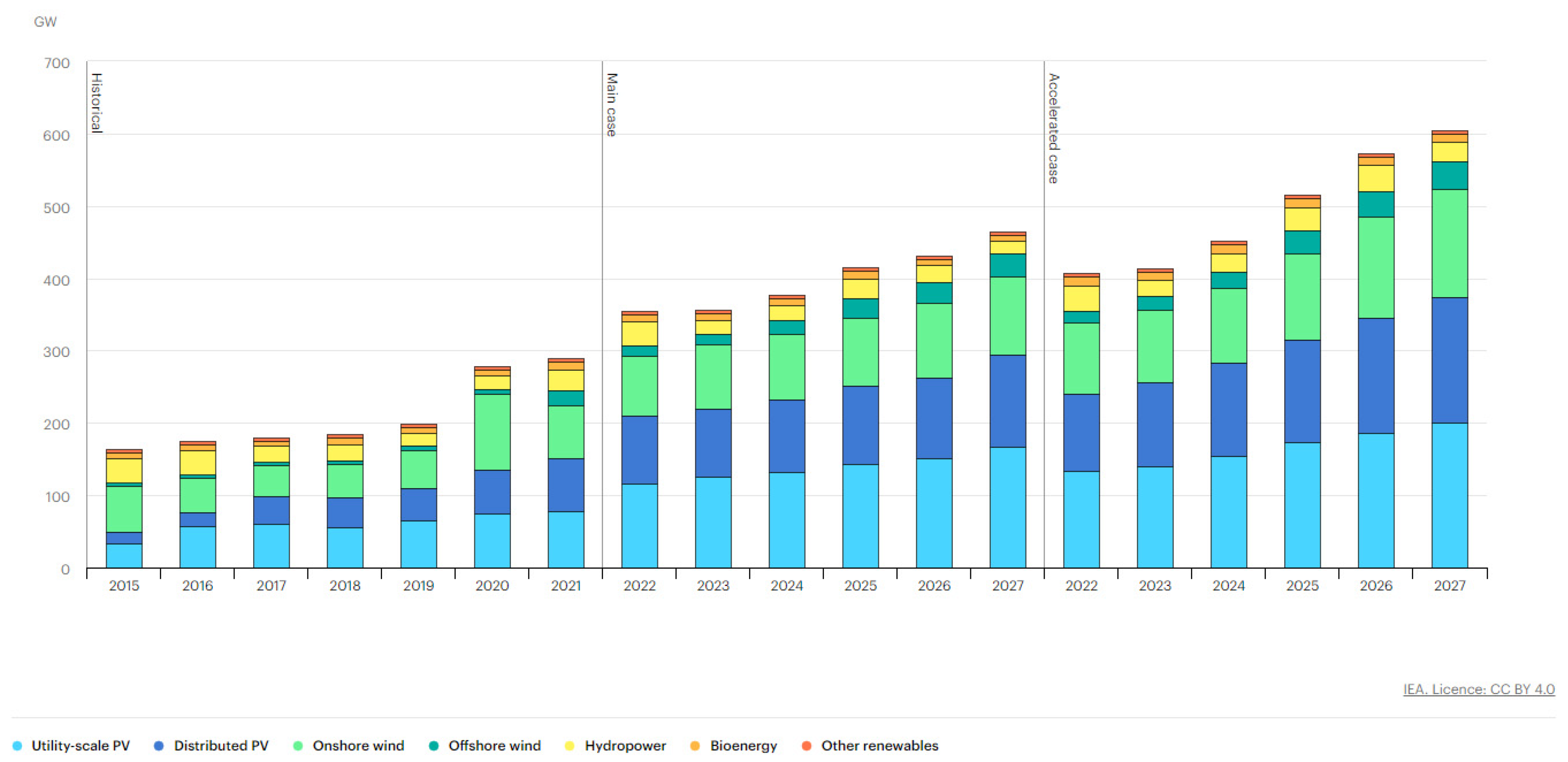
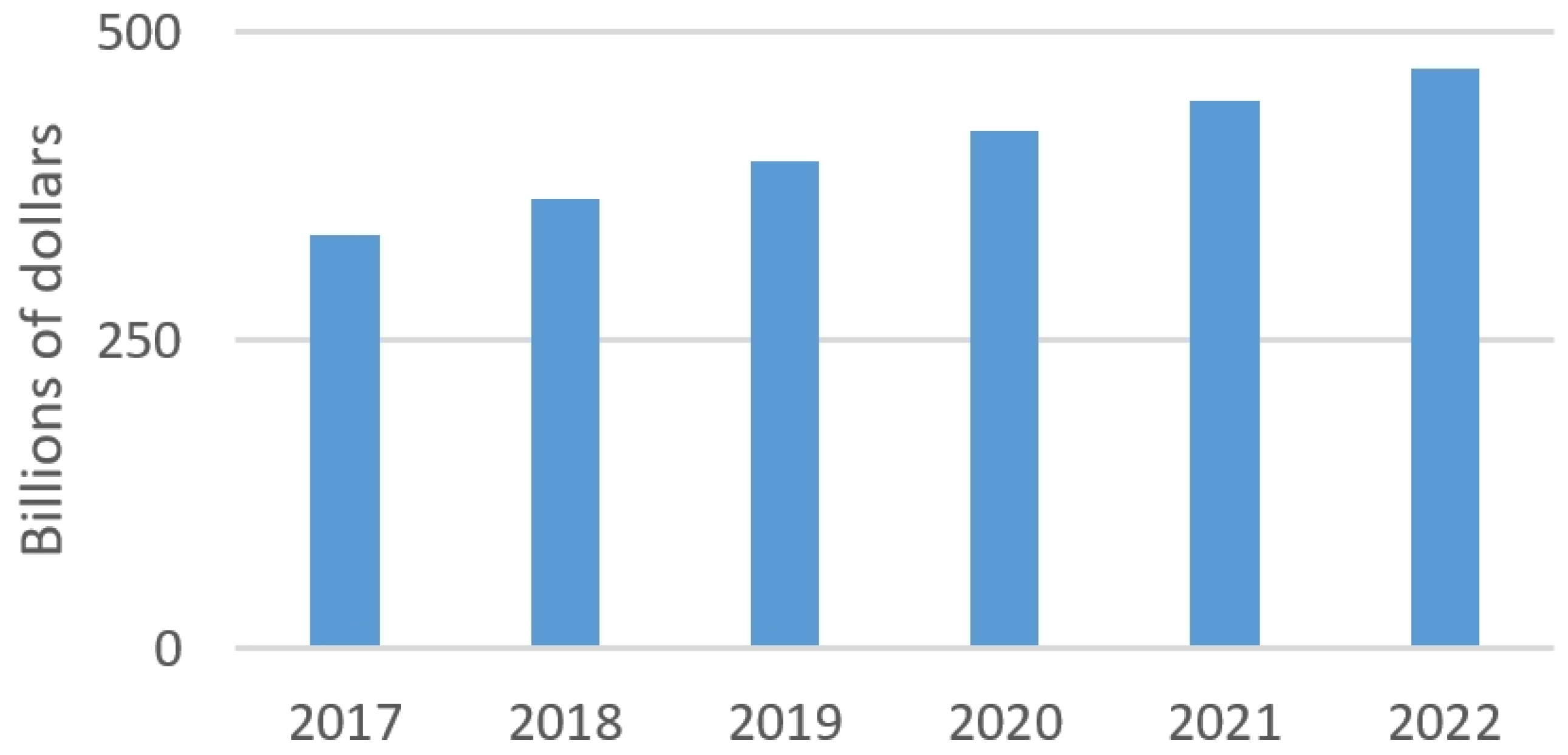


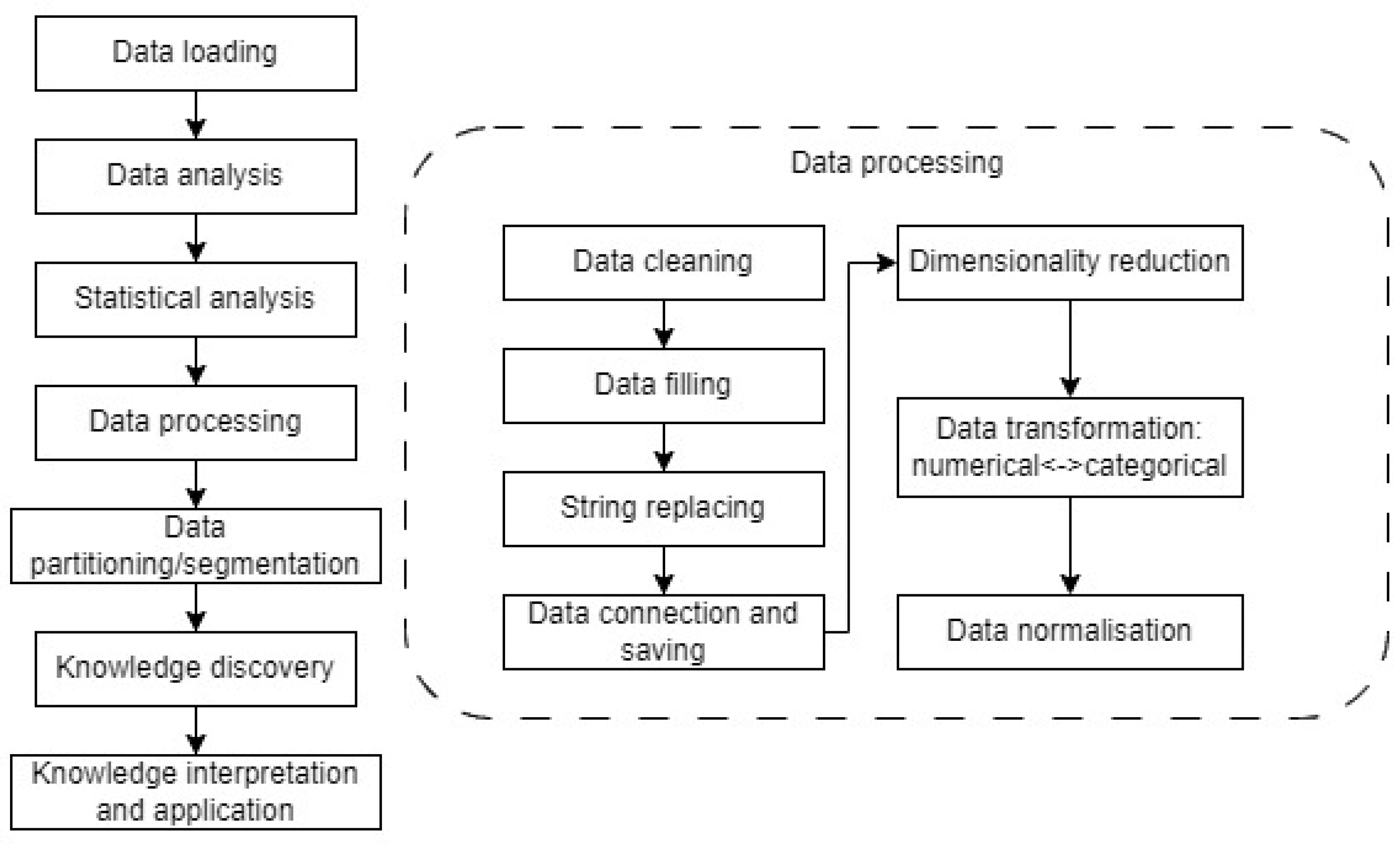
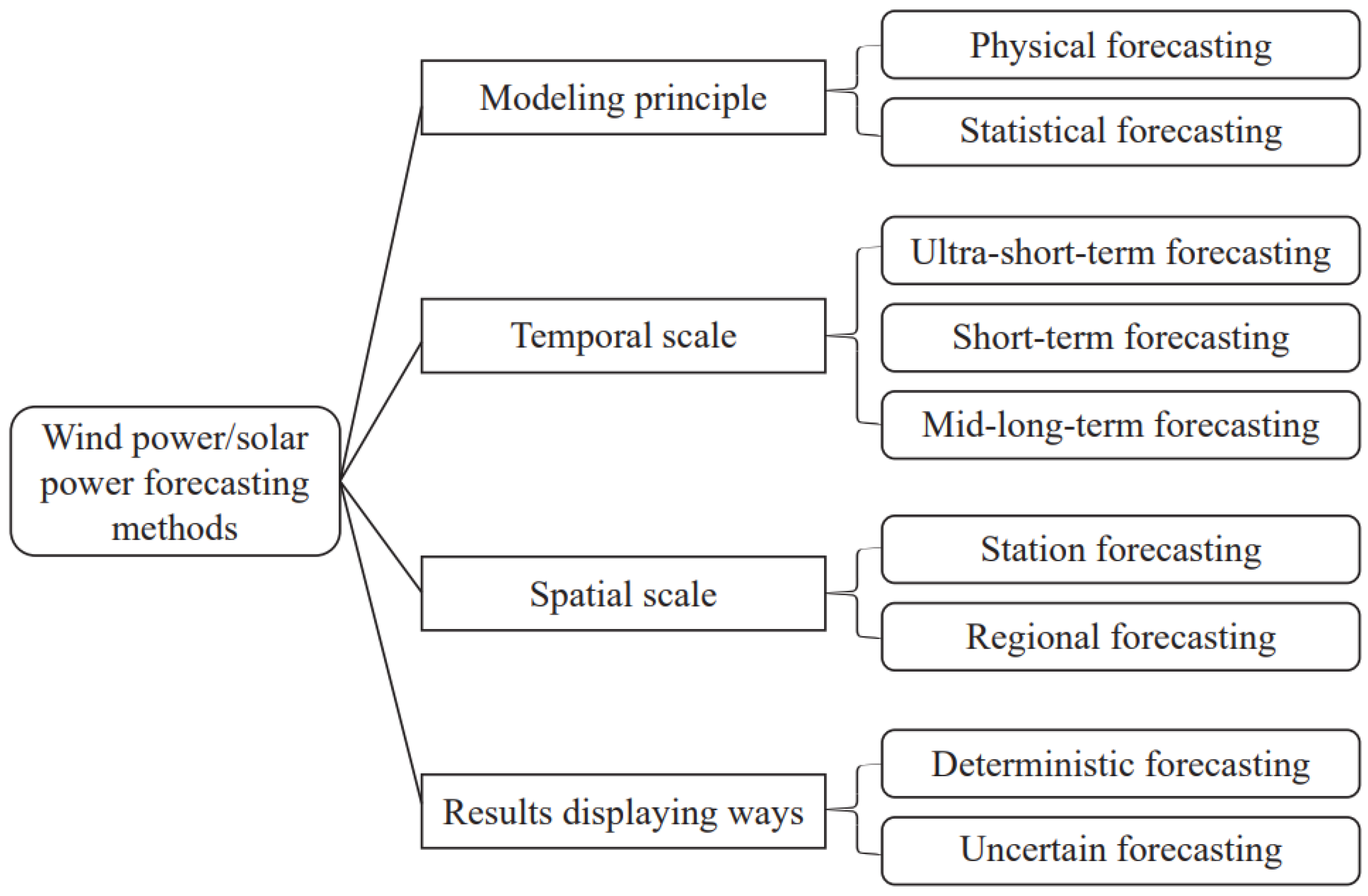
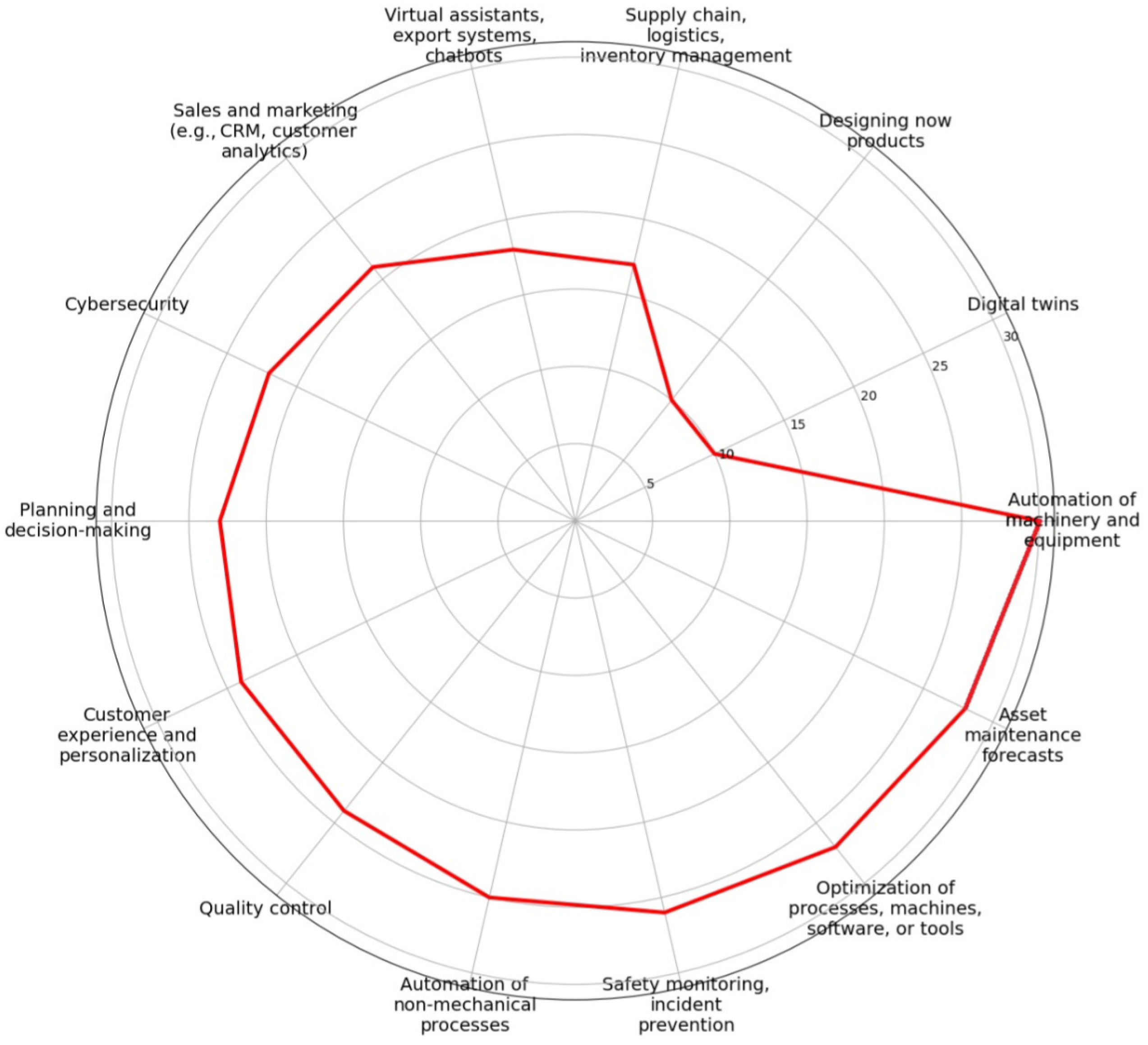
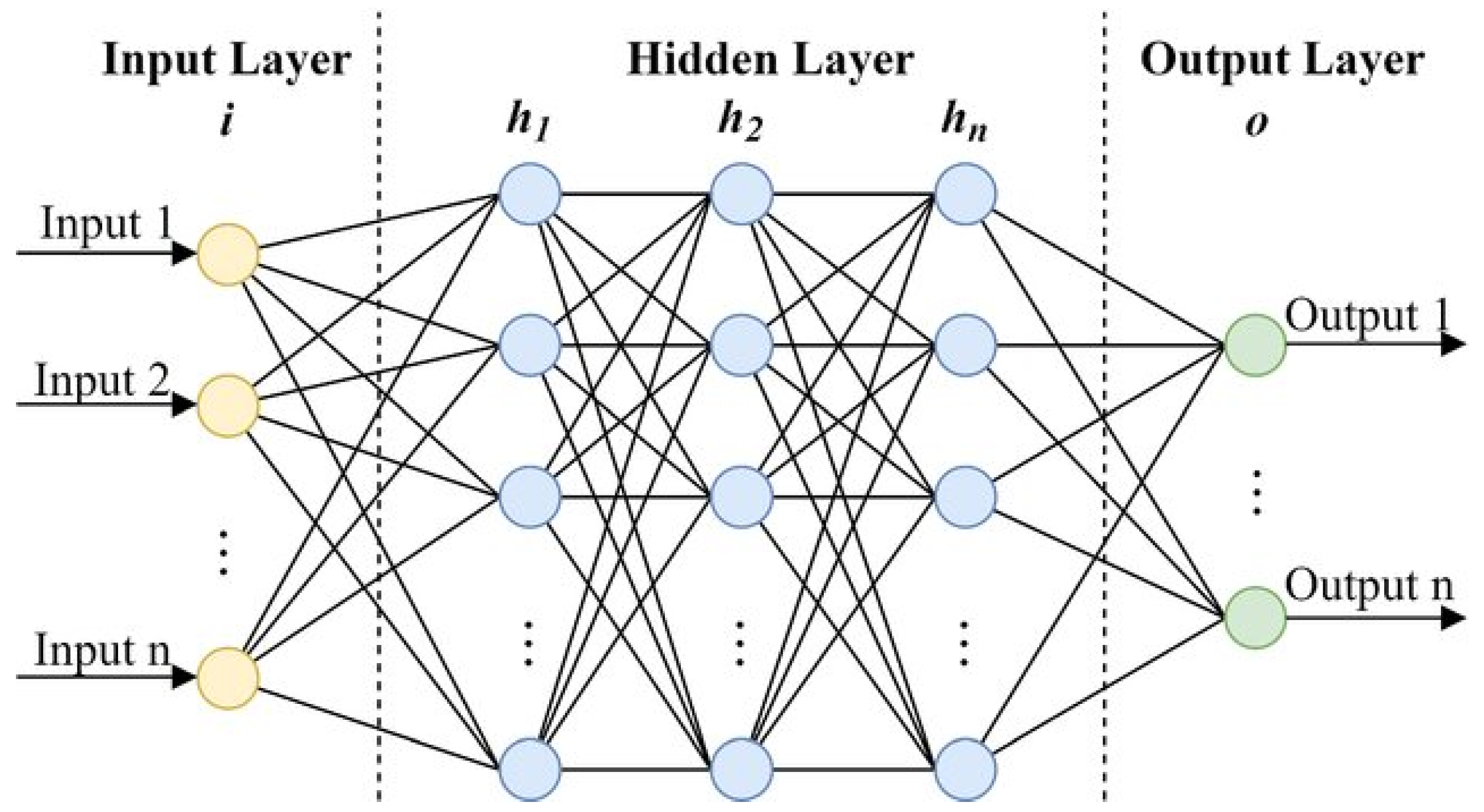
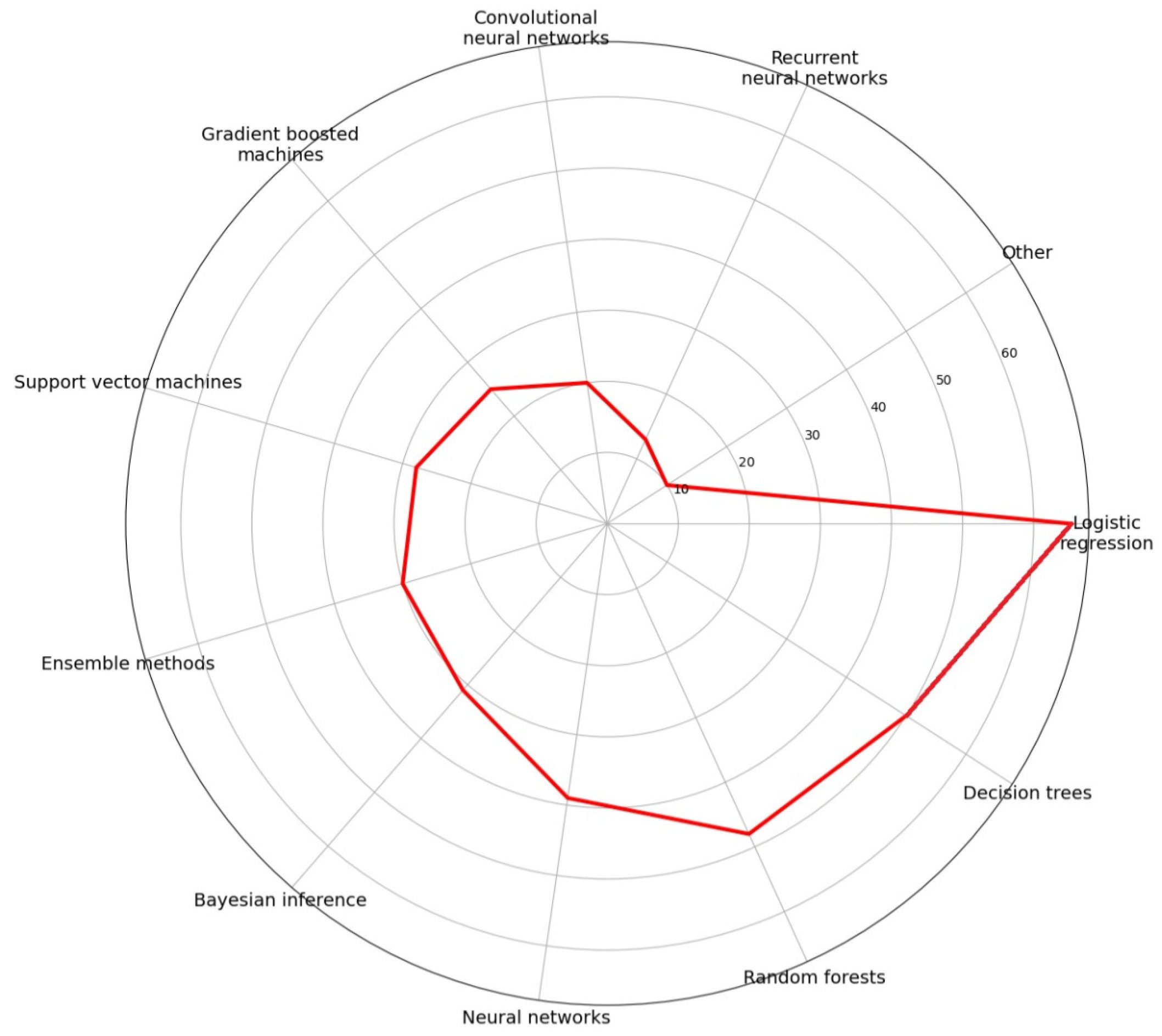
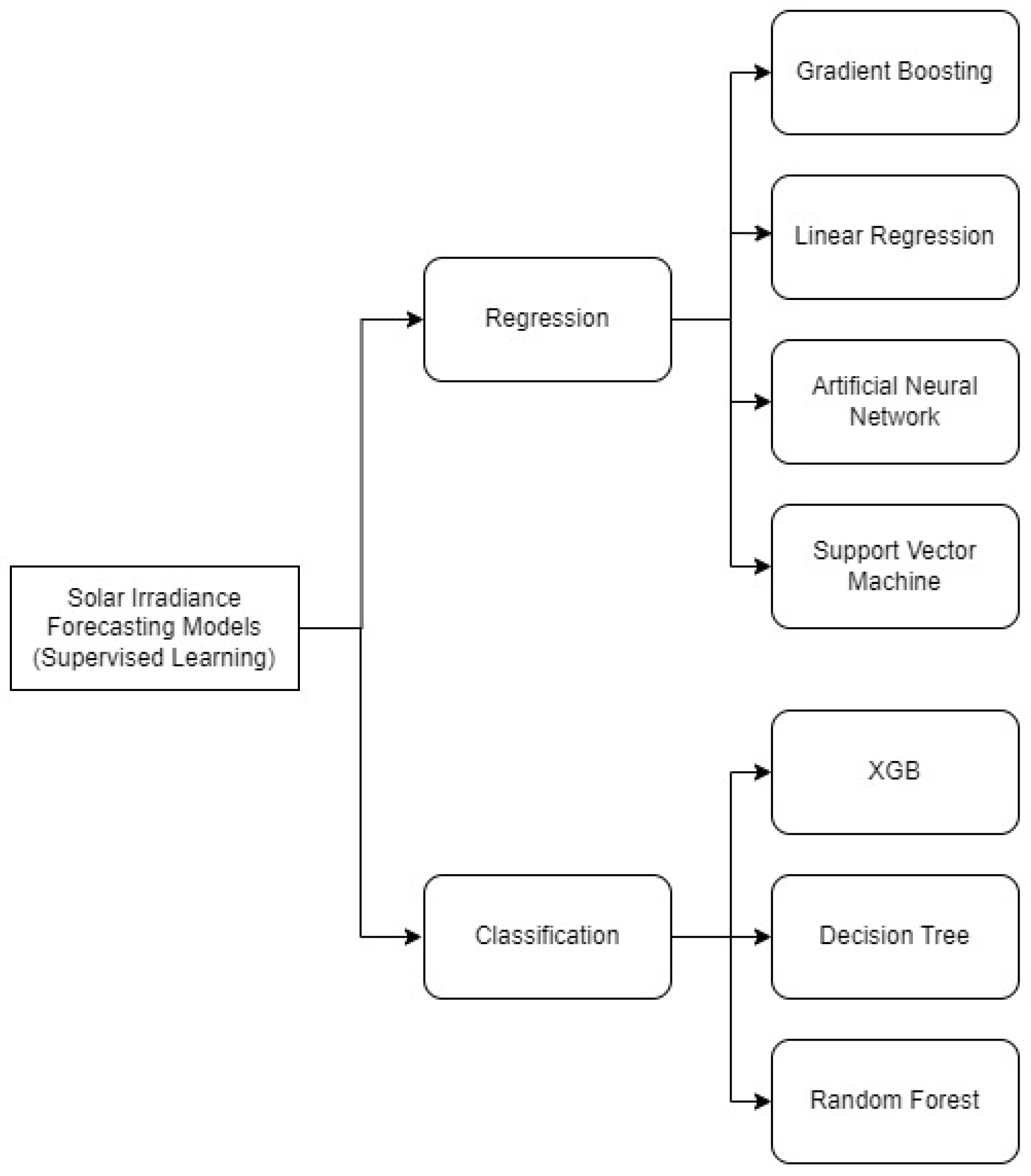
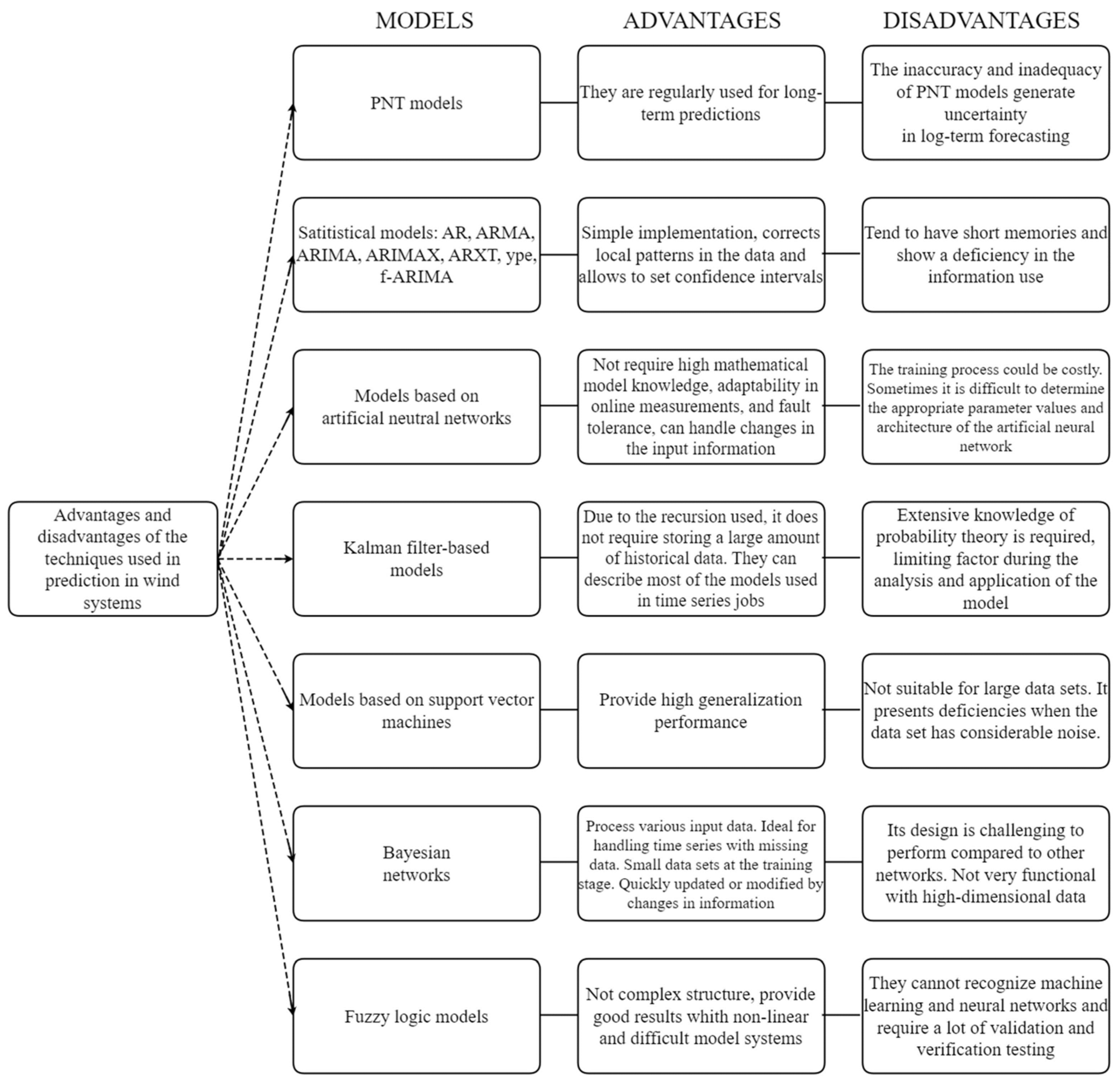
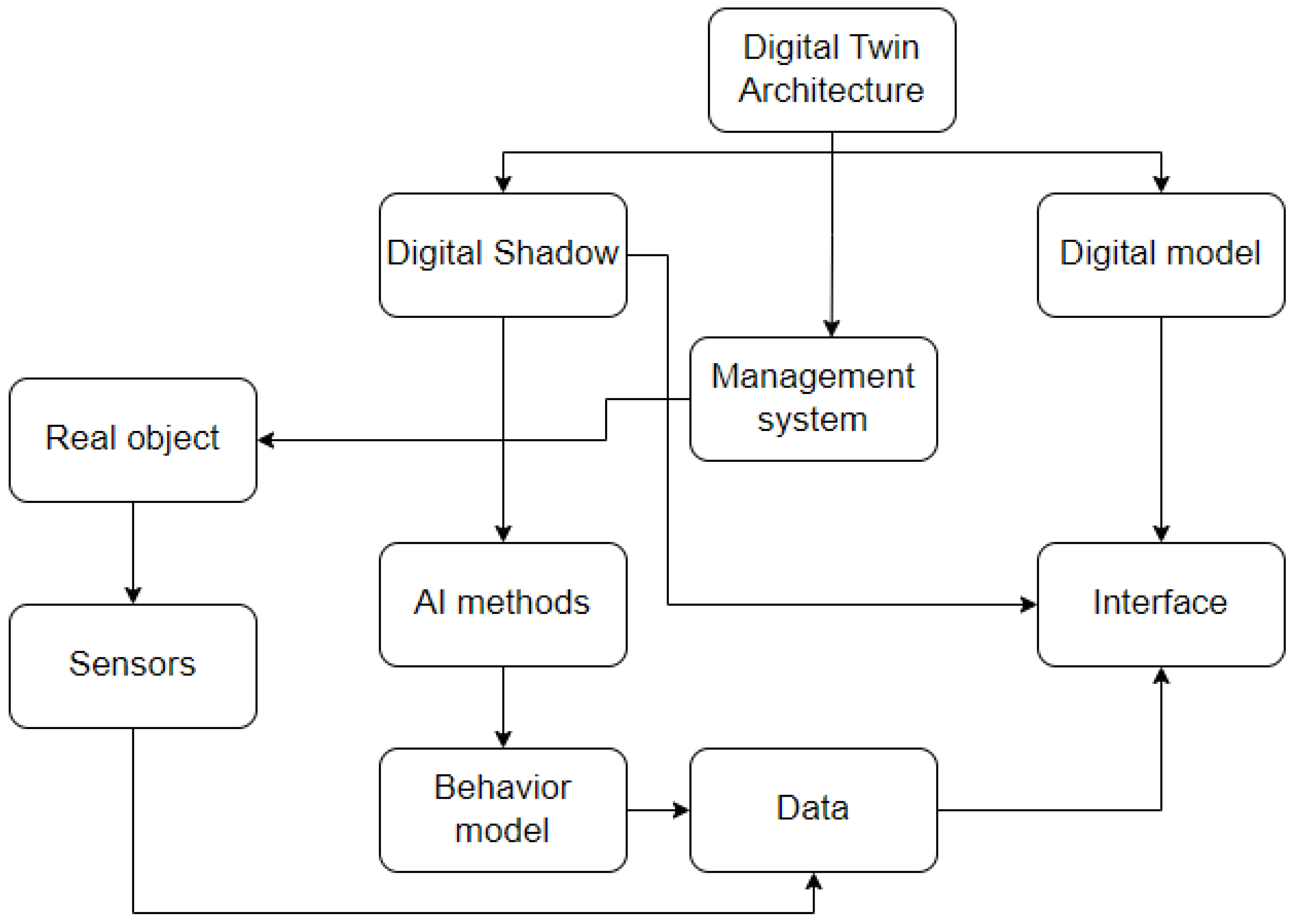

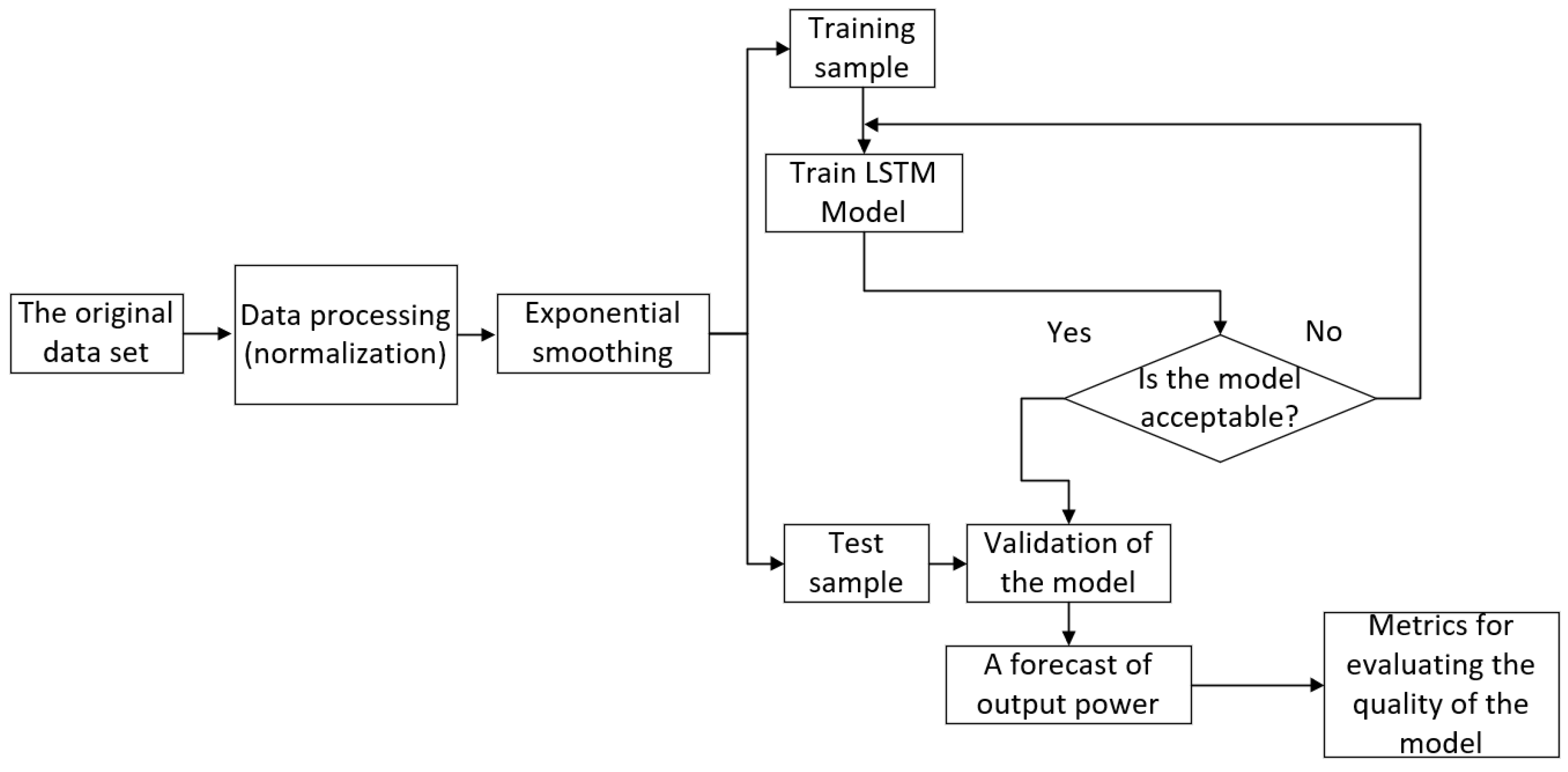
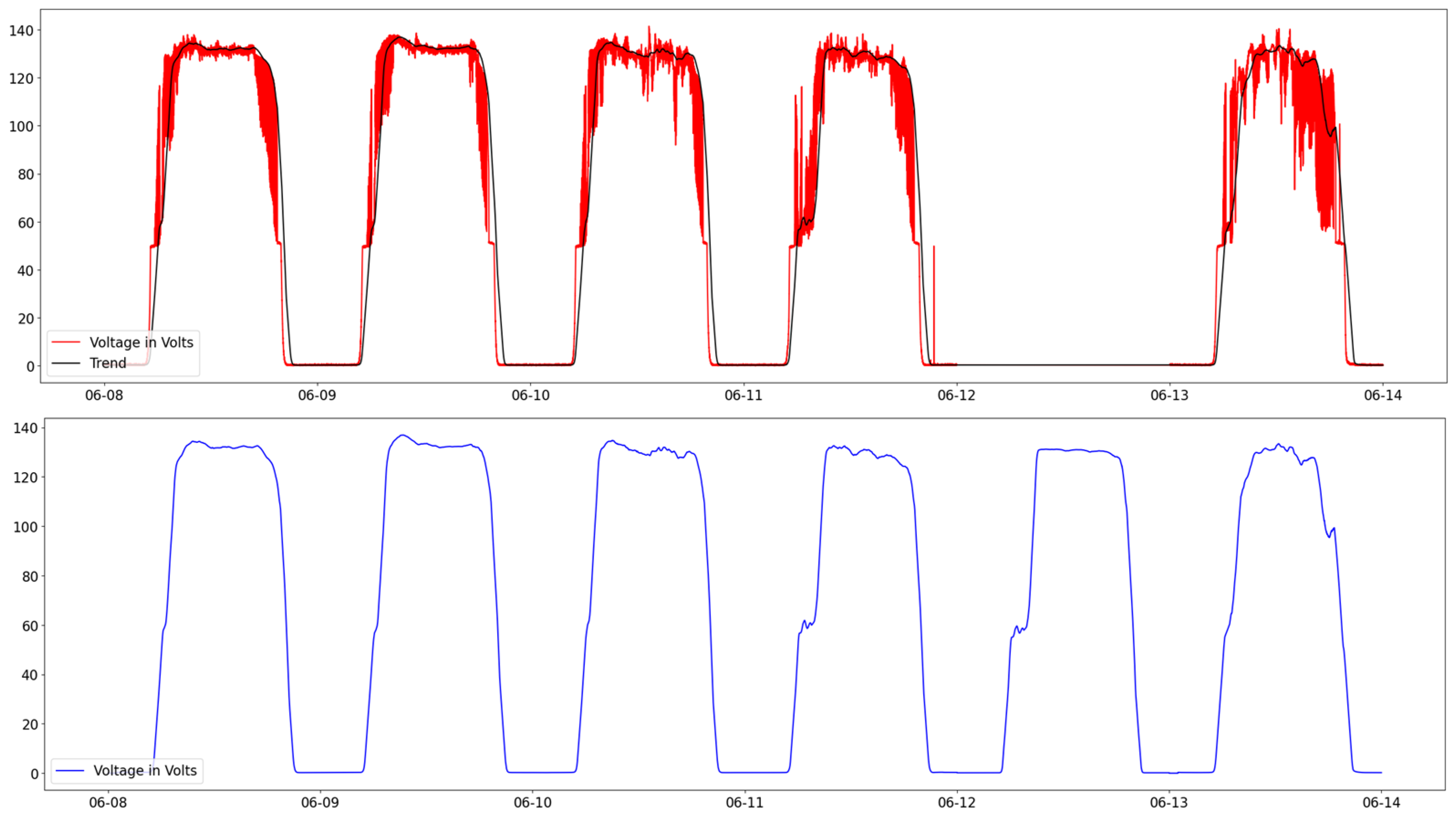




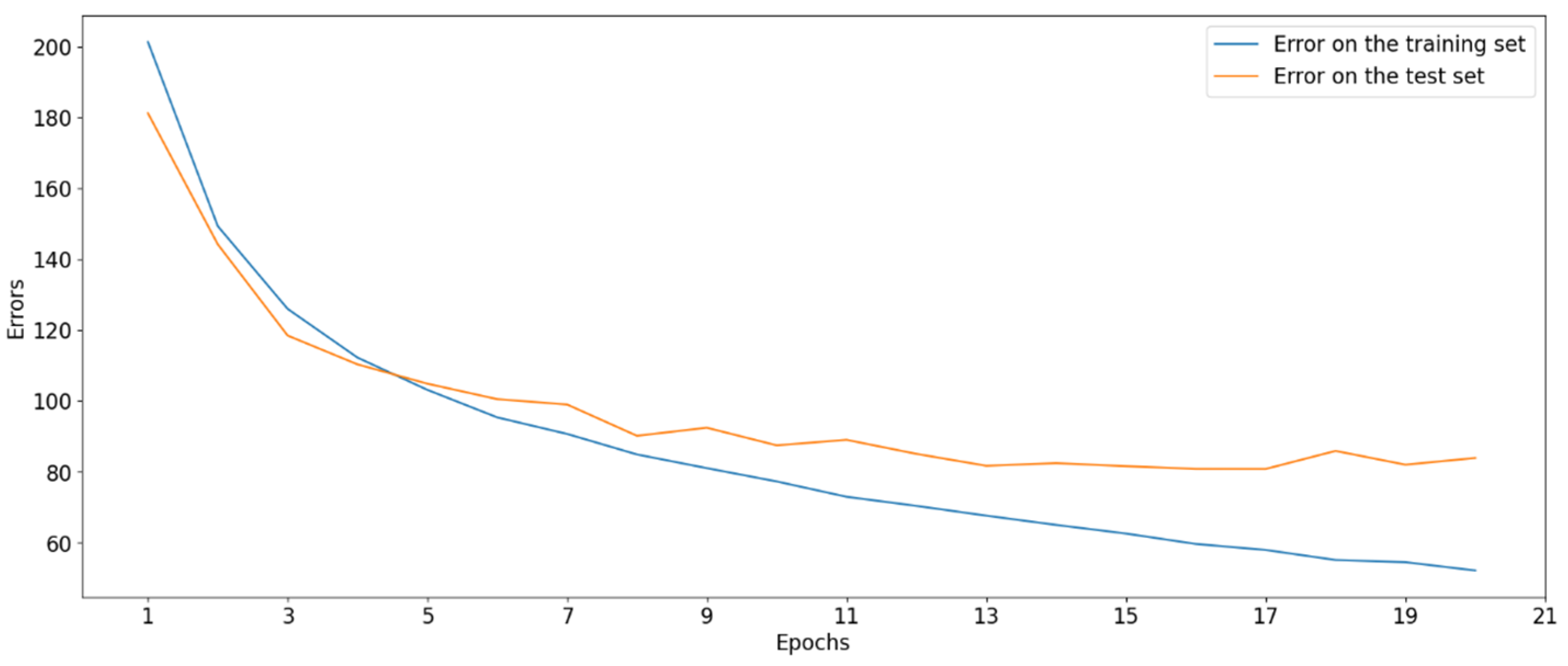
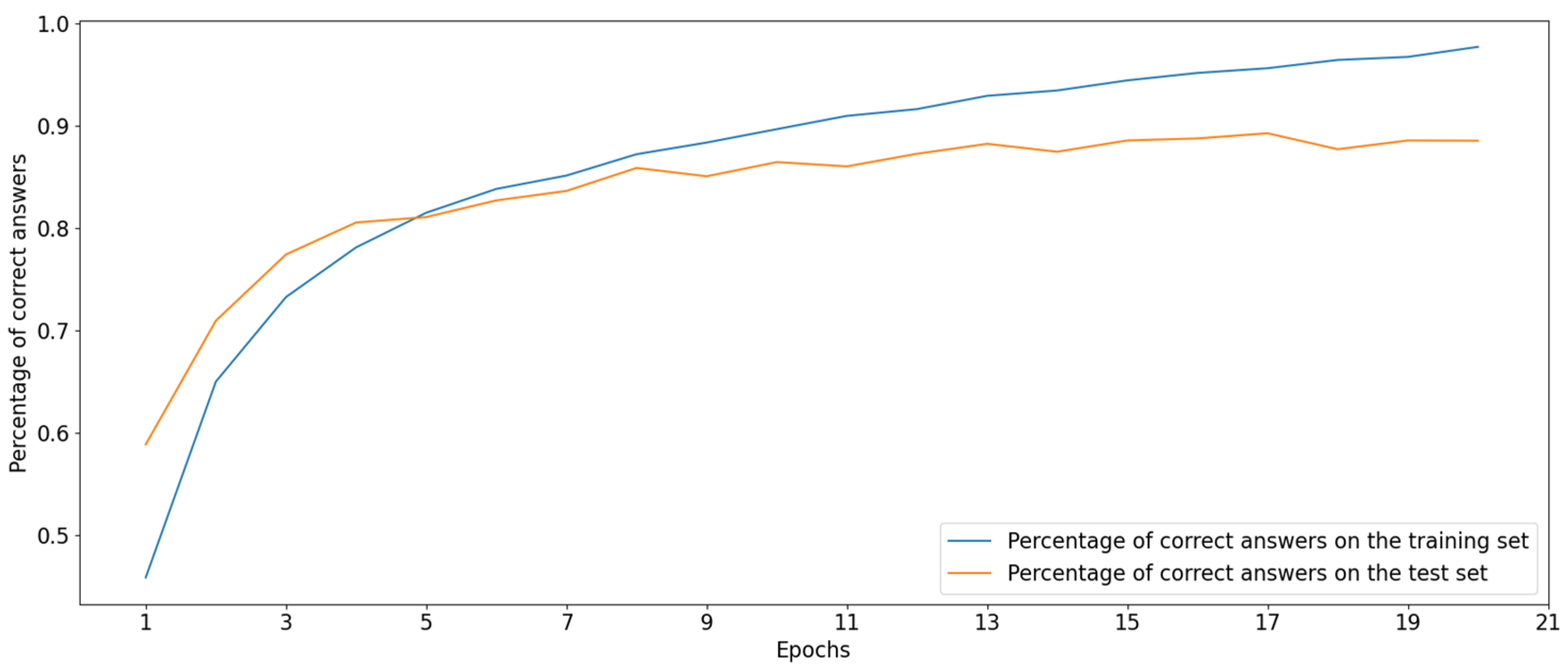
| Classification Criterion | Forecasting Method | Applicable Scenarios | Advantages | Disadvantages |
|---|---|---|---|---|
| Modeling principle | Physical modeling | Design of a new plant | It does not take a lot historical data | The complexity of the model increases exponentially as the forecast accuracy increases as the accuracy of prediction increases |
| Utilization within a plant during its operation | Time-consuming and computationally intensive | |||
| Statistical modeling | Power plants in operation | More broadly applicable scenarios | Requires a large amount of historical data to understand the series mapping laws | |
| Single/regional plants | ||||
| Classification criterion | Forecasting method | Applicable scenarios | Utilization of forecast results | |
| Timeline | Short-term forecasting | Forecasting interval up to 4 h | Operational economic dispatching | |
| Rotary reserve capacity optimization | ||||
| Capacity tracking | ||||
| Medium-term forecasting | Forecasting in the interval from 6 h to 3 days | Development and adjustment of station maintenance plans | ||
| Development of day-ahead dispatching plans for the electric power system | ||||
| Long-term forecasting | Forecasts for months, quarters and years | Organization of overhaul | ||
| Power system planning | ||||
| Site selection for wind and solar power plants | ||||
| Classification criterion | Forecasting method | Applicable scenarios | Forecasting approach | |
| Spatial scale | Point forecasts | Single station | Derived from conventional modeling | |
| Regional forecast | Multiple stations | Forecast regional power directly | ||
| First, a station in the region is forecasted, and then using the direct superposition method or statistical upscaling method, a regional power forecast is constructed | ||||
| Classification criterion | Forecasting method | Applicable scenarios | Forecasting approach | |
| Methods of displaying results | Deterministic forecasting | Scenarios require the results of point forecasting | Obtained using conventional modeling | |
| Uncertain forecasting | Scenarios require interval forecasting results | Probabilistic forecasting: parametric method, non-parametric method | ||
| Risk index forecasting | ||||
| Scenario forecasting: Monte Carlo algorithm, multivariate method of Gaussian multivariate autoregressive moving average model, etc. | ||||
| Stages | Actions |
|---|---|
| Step 1: Data preprocessing | Vpanel = pd.read_csv(‘WirenBoard.csv’, sep = “;”, usecols = [0, 7]) Vpanel = Vpanel.dropna() Vpanel.index = list(range(len(Vpanel))) |
| Step 2: Exponential smoothing | alpha = 0.2 exp_smoothing = [None, week[‘V_panel’][0]] for i in range(2,len(week[‘V_panel’])): exp_smoothing.append(alpha * week[‘V_panel’][I − 1] + (1 − alpha) × exp_smoothing[I − 1]) |
| Step 3: Trend Generation | week_trend = week_trend.rolling(window = 1600).mean() |
| Step 4: LSTM Model Definition | model = Sequential() model.add(LSTM(units = 50, return_sequences = True, input_shape = (features_set.shape[1], 1))) model.add(Dropout(0.2)) model.add(LSTM(units = 50, return_sequences = True)) model.add(Dropout(0.2)) model.add(LSTM(units = 50, return_sequences = True)) model.add(Dropout(0.2)) model.add(LSTM(units = 50)) model.add(Dropout(0.2)) model.add(Dense(units = 1)) |
| Step 5: Training the LSTM model | model.compile(optimizer = ‘adam’, loss = ‘mean_squared_error’) model.fit(features_set_train, labels_train, epochs = 20, batch_size = 32, use_multiprocessing = True) |
| Step 6: Prediction | forecast = model.predict(features_set) forecast = pd.Series(map(lambda x: float(x), forecast)) |
| Evaluation Metric | Equation |
|---|---|
| Error | |
| MAE | |
| MAPE | |
| MBE | |
| rMBE | |
| RMSE | |
| rRMSE |
| Forecasting Horizon | MAE | MAPE | RMSE | rRMSE | |
|---|---|---|---|---|---|
| 1 day | 2.3037 | 34.2641 | 5.1870 | 0.0586 | 0.9893 |
| 2 days | 4.7504 | 35.4937 | 5.6153 | 0.0622 | 0.9871 |
| 3 days | 11.4981 | 59.3267 | 20.2237 | 0.2530 | 0.8479 |
| Model | MAE | MAPE | RMSE | rRMSE | Source | |
|---|---|---|---|---|---|---|
| Exponential smoothing | – | – | 20.47 | – | 0.929 | [79] |
| ARIMA | – | – | 19.22 | – | 0.947 | [79] |
| Exponential smoothing | 2.5 (20 min) | – | – | – | 0.99 | [80] |
| Extra trees | 2.82 | – | 7.2 | 7.8 | 0.9526 | [82] |
| Random forest | 3.38 | – | 9.13 | – | 0.924 | [82] |
| LSTM | – | 8.93 | – | – | 0.98 | [94] |
| CLSTM | 11.42 | 3.62 | 18.01 | – | – | [95] |
| RNN | 7.75 | – | – | 5.69 | – | [96] |
| (FFBPNN) method | 5.256 | 7.066 | – | 4.673 | – | [97] |
| Gradient boosting decision tree | 6.02 | 3.3 | 6.73 | – | – | [98] |
Disclaimer/Publisher’s Note: The statements, opinions and data contained in all publications are solely those of the individual author(s) and contributor(s) and not of MDPI and/or the editor(s). MDPI and/or the editor(s) disclaim responsibility for any injury to people or property resulting from any ideas, methods, instructions or products referred to in the content. |
© 2024 by the authors. Licensee MDPI, Basel, Switzerland. This article is an open access article distributed under the terms and conditions of the Creative Commons Attribution (CC BY) license (https://creativecommons.org/licenses/by/4.0/).
Share and Cite
Simankov, V.; Buchatskiy, P.; Kazak, A.; Teploukhov, S.; Onishchenko, S.; Kuzmin, K.; Chetyrbok, P. A Solar and Wind Energy Evaluation Methodology Using Artificial Intelligence Technologies. Energies 2024, 17, 416. https://doi.org/10.3390/en17020416
Simankov V, Buchatskiy P, Kazak A, Teploukhov S, Onishchenko S, Kuzmin K, Chetyrbok P. A Solar and Wind Energy Evaluation Methodology Using Artificial Intelligence Technologies. Energies. 2024; 17(2):416. https://doi.org/10.3390/en17020416
Chicago/Turabian StyleSimankov, Vladimir, Pavel Buchatskiy, Anatoliy Kazak, Semen Teploukhov, Stefan Onishchenko, Kirill Kuzmin, and Petr Chetyrbok. 2024. "A Solar and Wind Energy Evaluation Methodology Using Artificial Intelligence Technologies" Energies 17, no. 2: 416. https://doi.org/10.3390/en17020416
APA StyleSimankov, V., Buchatskiy, P., Kazak, A., Teploukhov, S., Onishchenko, S., Kuzmin, K., & Chetyrbok, P. (2024). A Solar and Wind Energy Evaluation Methodology Using Artificial Intelligence Technologies. Energies, 17(2), 416. https://doi.org/10.3390/en17020416







